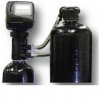ditttohead
Water systems designer, R&D

This post is intended for the people in here that have extensive field knowledge. I am building a prototype to replace my last prototype system that has worked perfectly for many years. I design and test units regularly and once my testing is complete I usually reinstall the old design into a family members house. This new design is completely over the top. I am trying to build a single valve system with 4 different medias using off the shelf, non special ordered items. Most of my previous prototypes include a lot of hand machined parts. This design will have one hidden adapter that is not yet available, but shoud be in the fall. Here is the general design:
1: Fleck 7000XTR
2: 10x22 double open tank, 1/2 cu. ft. Turbidex or equivalent.
3: 14x47 tank w/ 10% crosslink resin, 2 cubic feet
4: 24 pounds of KDF-55 in a 7x18 tank
5: Catalytic GAC, 2 cubic feet in a 12x47 tank
The diagram below shows the water flow. All of my math calculations show a minimal pressure drop for a residential application and I should be able to maintain a peak flow rate of over 15 GPM. Sevice flow will be slightly less, but the truly functional medias at higher flow rates will be the softener and GAC tanks. The KDF is limited in its service rate but it will flow over 20 GPM in this configuration. Here is the question, for a municipal water application, other than being completely ridiculous, is there any major flaws in the design that you can see? I am hoping to have a system built and installed in a coupl of weeks. I am working on an article for publication in September and this system will be a small part of it if it works. One of my biggest concerns has been the frequeency of backwashing for the KDF, but this has proven to be a non issue in my old design which also includes a similar KDF tank backwashing approximately every 10-15 days. I have 20 of those units on the feild for testing and all have worked for many years without failure of the KDF.

Attachments
Last edited:




